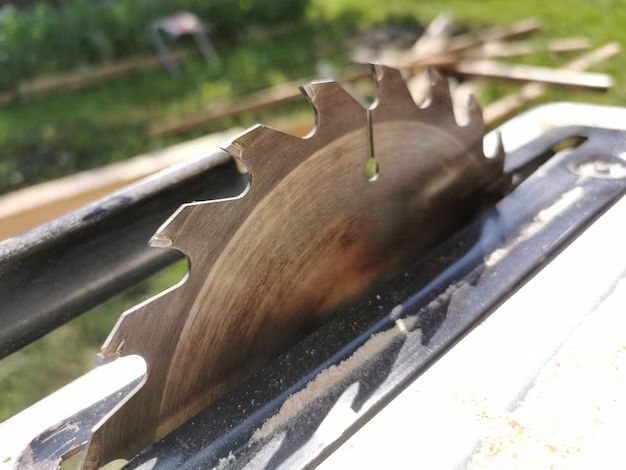Cross cutting on a table saw refers to cutting a board perpendicular to the grain. This allows you to cut boards to length or trim material to size. While many woodworkers primarily use the miter gauge for cross cuts on a table saw, there are some limitations to this approach. The short fence on a miter gauge can make it tricky to support large or awkward boards during the cut. Additionally, miter gauges often don’t have the precision needed for accurate cross cuts. So can you reliably perform cross cuts on a table saw without a miter gauge? Let’s take a closer look at the options.
Page Contents
Using a Miter Gauge
A miter gauge is a common table saw accessory designed specifically for cross cutting. Most miter gauges slide into the t-slot on the saw’s table, allowing the angle of the cut to be adjusted. To cut across the grain, the miter gauge is simply positioned perpendicular to the blade. Here are the pros and cons of using a miter gauge for table saw cross cuts:
Pros:
- Purpose-built for cross cutting on a table saw
- Angle is easily adjusted with positive stops at common angles
- Relatively inexpensive accessory
Cons:
- Limited cut width due to short fence
- Can lack precision due to sloppy fit in t-slot
- Don’t always allow cutting all the way through wider boards
For cut-offs and trimming smaller boards to length, a miter gauge may provide all the functionality you need. But the capacity limits mean you’ll need other options for larger cross cuts.
Crosscut Sled
Many woodworkers create crosscut sleds specifically built for table saws. A sled provides an extended fence to support the work through the cut while maintaining the blade perpendicular to the fence. Benefits of a crosscut sled include:
- Fence steadies the work and prevents binding on the back of the blade
- No capacity limitations, depending on size
- Repeatable precision with PTFE glides and incremental stops
- Safety from keeping hands further from the blade
Well-made crosscut sleds ensure square cuts every time. And various hold-downs and toggle clamps can be added to secure the workpiece during cutting. The primary downside is that sleds take more time to construct and fine tune compared to just using a miter gauge. But for a table saw user that does a lot of crosscutting, a sled is an excellent investment.
Miter Saw
For ultimate convenience and speed, a miter saw is actually better suited for crosscutting than a table saw. The layout of a miter saw allows the workpiece to be placed directly against the fence perpendicular to the blade. And the blade pivots down through the material for fast, accurate cuts time after time.
Miter saw pros:
- Quick and easy for repetitive crosscuts
- Very accurate due to fixed fences
- Safer than table saw with hands away from blade
- Available in range of sizes from compact to over 12″ capacity
The trade-off is that a miter saw can’t rip cut boards to width like a table saw. But when focusing on crosscuts, a miter saw is definitely a better choice. Some woodworkers even opt to have both a miter saw and a table saw to get the ideal capabilities of each tool.
Panel Saw
Panel saws are a variation of the table saw designed specifically for breaking down large sheet goods. They have an extended table in front of and behind the blade to support massive panels or sheets for cutting. Outfeed and support rollers make it feasible for a single user to manage full 4×8 sheets.
Benefits of a panel saw for cross cutting include:
- Huge ripping and crosscutting capacity
- Allows breaking down plywood, MDF, and other sheet goods
- Increased safety due to minimized movement and vibration
The trade-off is significantly higher cost than a contractor saw. But for a professional shop doing extensive work with large sheet stock, a panel saw is an indispensable tool. Along with sheets, a panel saw also excels at crosscutting dimensional lumber up to 12′ long. But for smaller scale work, this would be overkill.
Circular Saw + Guide
For truly large crosscutting applications, a circular saw with an accurate guide may be the best approach. Plunge cutting with a track saw system allows breaking down huge slabs. And using a straight edge guide clamped across a sheet achieves the same end result.
Circular saw pros:
- Able to cut widths beyond table saw capacity
- Portable for on-site work
- Plunge cutting eliminates tear out
- Guides maintain a straight edge across full sheets
Freehand cutting with a circular saw cannot match the accuracy of a table saw. But add in an edge guide, and you can achieve the same result with wider stock. The cut edge also rivals a table saw with the clean plunge cutting action. For serious crosscutting capacity, consider a circular saw and guide rail system.
Conclusion
While a miter gauge is the standard table saw accessory for cross cutting, it has limited width capacity. More advanced options like crosscut sleds and miter saws excel for this purpose. And when working with oversized stock, track saws or panel saws can handle cross cuts that a table saw simply can’t achieve. The right tool depends on the types of cuts and material sizes you expect to encounter. But with the range of options covered here, you can certainly accomplish professional cross cuts on a table saw or other tools in the shop.
